Candi Borobudur
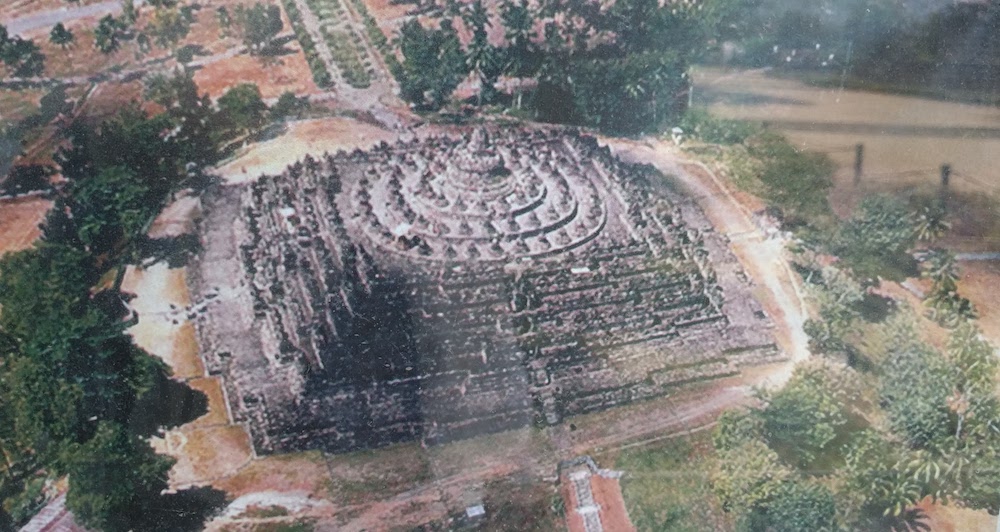 Aerial shot of Borobudur
Aerial shot of Borobudur
On our 3rd day in Borobudur we visited the temple (Candi), which is why the town exists. The temple has a fascinating history and is the largest Buddhist temple in the world, despite being located for many centuries in a region that is predominantly Muslim with virtually no Buddhists. At the time of its construction in the 9th century, Buddhists and Hindus were coexisting in central Java with some degree of harmony. (Candi Prambanan, we visited on the next day, is largest Hindu temple in Indonesia, built around the same time and only 50 km away). When a volcano erupts, the Javanese have the custom to pack up and pick a different place to live (seems like common sense); this happened in the 10th century so they abandoned Borobudur and Prambanan (both covered in volcanic ash and toppled) and settled mostly in Eastern Java to build new temples and start over. In the 19th century both sites were “rediscovered”, thus gaining international attention.
 Stonework at Borobudur
Stonework at Borobudur
Borobudur temple, has 9 levels, constructed like a step pyramid. These levels are broken into sections representing realms of Buddhist cosmology, and 1,460 relief sections surrounding the levels tell stories of the stages of the Buddha’s spiritual development to enlightenment. Aside from the reliefs, the temple has 504 life-size statues of Buddha geometrically arranged, and those on top veiled in stupas. Truly an impressive sight, and difficult to capture with my camera. Much work has been done to restore the structure, and the reliefs and other stonework have retained a lot of detail over a millennia.
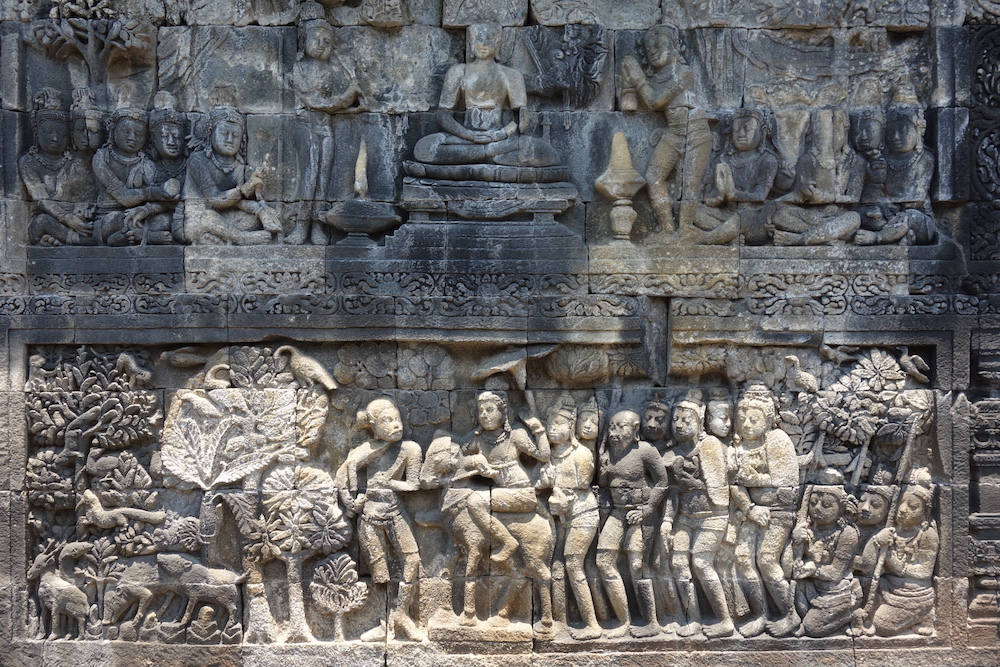 Example of relief at Borobudur
Example of relief at Borobudur
As the morning grew late, the sun was more intense and the tourists and visitors packed in tighter. In spite of its Buddhist symbolism, Borobudur is a revered as a source of pride for all Indonesians. We saw many Indonesians school groups flood the area.
Candi Prambanan
 Entrance to Candi Prambanan
Entrance to Candi Prambanan
Prambanan temple was our stop on the next day, on our way to our next guest house in Yogyakarta. The biggest Hindu temple in Indonesia, Prambanan was also quite impressive. In contrast to the singular structure of Borobudur (and it’s “non-theistic” Buddhist values), Prambanan is a temple compound of several related temples, mainly to the principal Hindu gods, Shiva (destroyer), Brahma (creator) and Vishnu (preserver). Inside each temple was one or more cave-like rooms, each with a statue inside representing the god or lesser gods in relation. The complex of temples is meant to represent the layers of Hindu cosmology.
 Prambanan chamber Ganesha statue
Prambanan chamber Ganesha statue
While based on different fundamental ideas, there seemed to be many similarities to Borobudur temple. There were reliefs around each temple, collectively telling the story of Ramayana especially important in Indonesia and throughout Southeast Asia. Shapes and stone carving styles seemed quite similar as well. I enjoyed just examining the details and textures of the carvings.
 Stonework at Prambanan
Stonework at Prambanan
After leaving Bali we spent a week and half in Java (4 nights in Borobudur, 4 nights in Yogyakarta). Borobudur town was a 1.5 hour drive from Yogyakarta airport. A quiet town, with hot and dry weather — we seemed to come at height of the dry season.
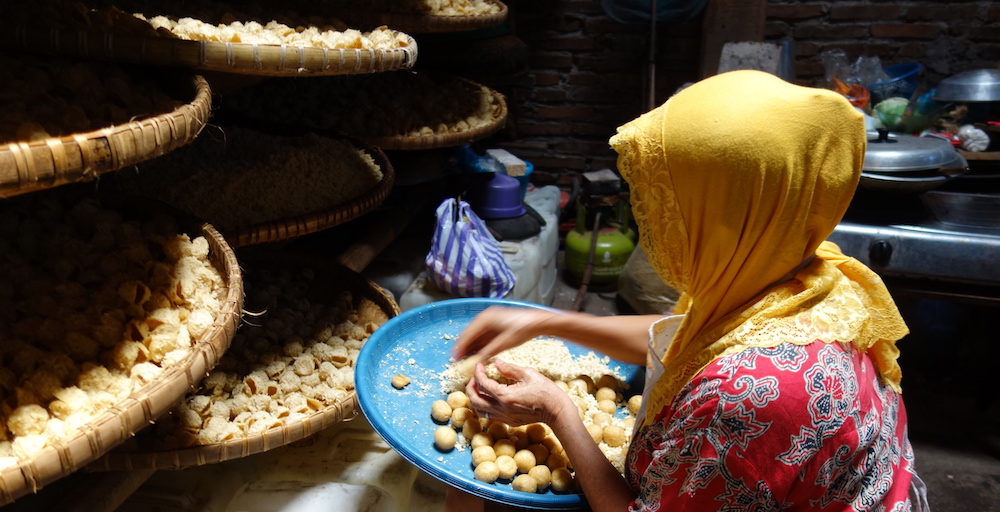 Drying racks of tofu balls
Drying racks of tofu balls
Our second day we were ready to explore on a moped. We toured a small tofu factory and were treated with some fried tofu balls that were being turned inside out to be dried and prepared as bagged snacks. This was next to a tobacco factory, with giant piles of shredded tobacco. The tobacco plants grow very well in the dry season, and were seen growing in fields all over. When dry season finishes, there are two seasons for growing rice. Throughout Indonesia it’s our experience that nearly every man smokes, women rarely.
 Mountain of Tobacco
Mountain of Tobacco
We skeptically joined a guided tour by horse carriage. The three of us played some simple gamelan in a music classroom, ate some local treats and learned more about the history of the region from our guide.
Outside Bali our food options have become more limited. Along streets you can see signs for warungs (the word for a small family restaurant or cafe in Indonesia) which prepare food for buffet style (or usually point-and-eat) items to eat usually with white rice. In Java, there were fewer non-spicy options. Asa’s spice tolerance has increased marginally, and Kanako can have a little bit, while my tolerance has increased a lot.
Still, we’ve remained very healthy, though the first morning in Borobudur Asa and Kanako toured the farm animals around the guest house — Asa had fun feeding the cows — but they soon fled after being attacked by fleas. The fleas were tenacious and left Kanako with a number of bites, Asa not so bad.
Having heard news that Agung volcano was rumbling, it seems to be the right time to say goodbye to Bali. Now it’s been just over 2 months since we left Japan, most of that spent in Bali. Feels much longer.
For convenience and to greatly lower our expenses we decided to rent a moped for getting around Ubud. It wasn’t an easy decision, since we were hesitant especially traveling with a 3-yr old. So we made sure we had protection. Helmets, sunglasses, face masks (for the smoke and exhaust), and long-sleeve shirts (for the sun).
Mopeds seem to own the streets here, gliding through traffic in all directions like salmon navigating a rushing river. Cars, taxis, and trucks get stuck everywhere with a minimum of traffic lights on the island — and pedestrians fare no better. My time riding a moped in the Dominican Republic 15 years ago came in handy. Asa, hesitant at first, eventually warmed up to it. To ride a moped in Bali is to see and move through life like a local — later we learned that this is basically everywhere in Southeast Asia, from cities to rural farmlands.
It’s a little scary at first, I think more so in Bali than other places on our trip. Of course it’s not without risks. We saw many ambulances, mostly in the evenings carrying careless drunk tourists, or the ones they ran into. We rarely rode the moped after dark. After getting used to new environs, I usually tried to ride like a local at the speed of traffic.
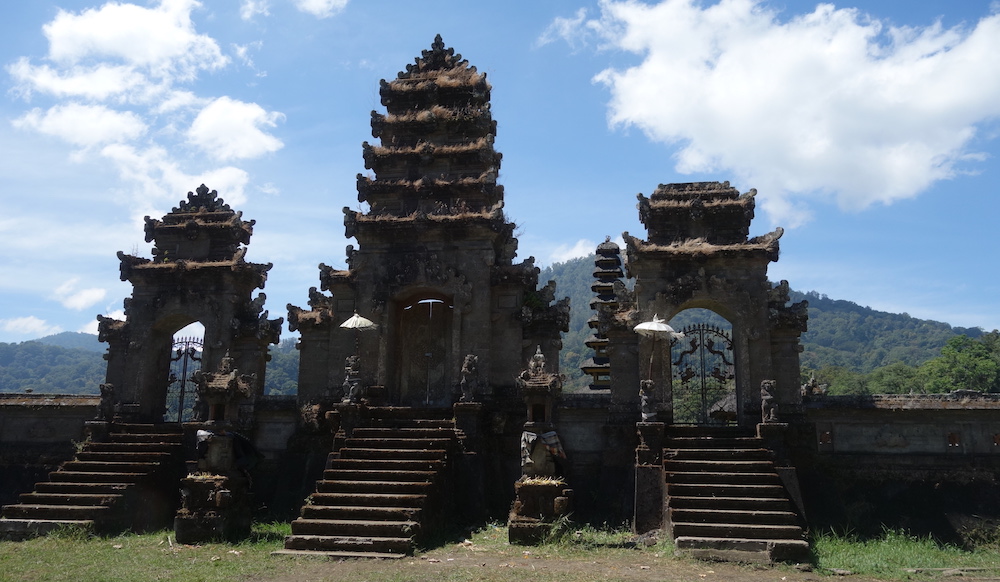 Water temple at Lake Tamblingan
Water temple at Lake Tamblingan
2 weeks ago we rode the moped about 2 hours drive up the mountains to pass by three lakes (Bratan, Buyan and Tamblingan) to stay in Munduk, a small mountain town. On our way back to Ubud we stopped and at lunch in Jatiluwih, a world heritage site (Tabanan Regency - Wikipedia), famous for its endless span of rice field terraces covering every square meter. Overall it was a very pleasant drive through farmlands, up and down some steep mountain roads. The brakes were getting a little overheated, which led to a couple scary spots. But then I figured out a better way to brake by alternately pumping the front and rear brakes.
 Rainy day at Jatiluwih
Rainy day at Jatiluwih
Ceremonies
Last week (late September) was a time of many ceremonies in Bali. Kanako and I spent a day at our previous guest house in central Ubud. The family invited us to come see the house blessing ceremony. On their relatively small property they hosted hundreds of family, extended family, friends and neighbors. Lunch and treats for everyone, as well as performances from a gamelan ensemble, an entertaining Topeng dancer (Topeng - Wikipedia) and a one-man puppet theater.
A small ceremonial house was built on their property, and was the centerpiece for the rites of the ceremony, much of it a mystery to us. But the basic idea is to purify the recent houses they have constructed so that they will actually come alive — that is, with an animistic spirit inside.
 Cremation ceremony in Pengosekan, Ubud
Cremation ceremony in Pengosekan, Ubud
A couple days later we attended the cremation ceremony held in the neighborhood we are staying. Special cow statues were constructed of wood, and placed on platforms that strong men paraded around the streets with a loud percussion band. Later the exhumed bodies of a dozen people, all deceased within the last couple years, were placed inside the cows. The cows were then carefully set on fire with gas torches. The cow eventually starts to crumble, and when the body falls through belly of the burning cow the spirit is released and is allowed to ascend to heaven. Or anyway, that’s about as much as I understood.
Returning to Bali, after a short trip to Kuala Lumpur we spent 5 weeks in Ubud. Ubud was a very different experience from our time in Canggu in July – different in good ways. Though Ubud is far from the beach, the streets are a little more manageable, and Ubud and the surrounding region has a big arts / crafts scene.
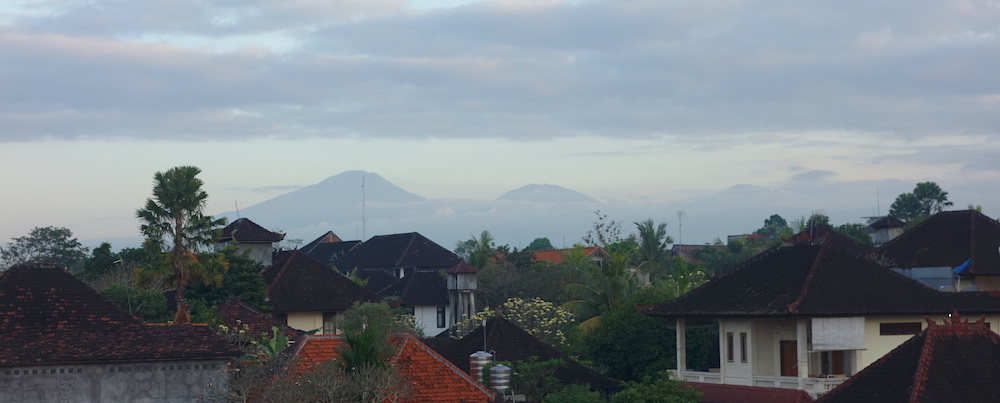 Mountain view from our guest house
Mountain view from our guest house
Traffic is more congested in Ubud – though it was the high season, I kept wondering how can it possibly withstand more congestion in the coming years? It’s a swarm of two-wheeled vehicles with the cars / taxis pushing through at a slow pace. Our first week in Ubud we were staying in the center of town and we mostly walked, but occasionally relied on taxis. Uber is available in some areas of Bali, but is quite restricted because local taxi groups threaten Uber drivers (because they drive down prices). But we had many interesting conversations with taxi drivers.
Temples are a common site. However, with or without Balinese inside, they often don’t seem welcoming to foreigners. All seem to be made of stone, much of it comes from local quarries. There is one river quarry along the river outside of Ubud, where I’ve seen stacks and stacks of the stones they use like bricks. This stone, usually dark gray, is soft, ideal for carving the ornate and intricate stone decorations that are ubiquitous in Bali.
In fact, every residence seems to have a temple or shrine, size varies by wealth and property size. At both places we stayed in Ubud, the property’s temple had to reconstructed and raised on platforms because they had built 2-story buildings for guests. The temple should be higher than everything else.
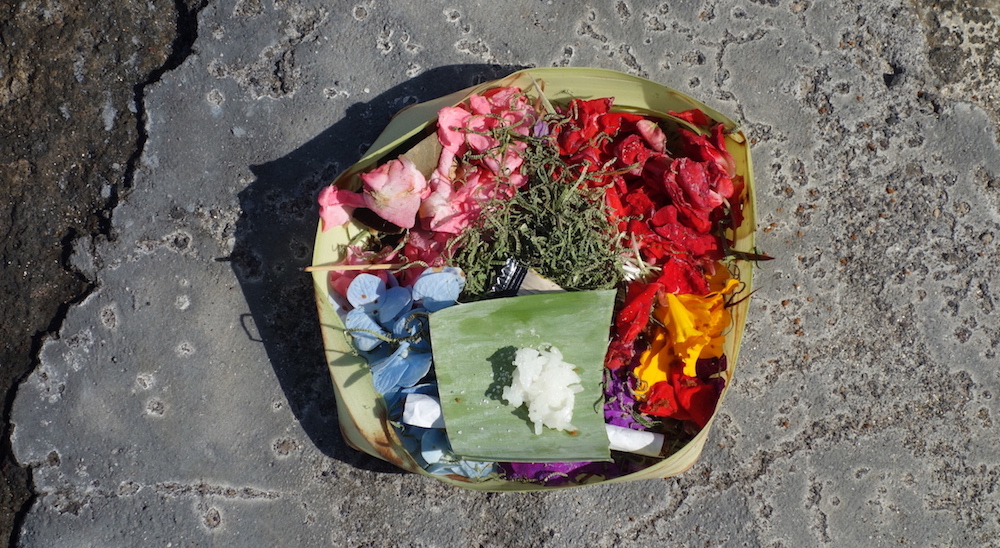 Common canang offering
Common canang offering
Small offerings (canang sari) are prepared everyday and everywhere – once blessed they are placed ceremonially at the entrance of every business, home, school, temple, etc. They are a huge part of daily life in Bali. The offerings usually consist of a small base of coconut leaves stitched together, with flowers of different colors placed on top, and finely cut leaves from a Pandan tree, then incense, and whatever else is appropriate for the occasion (rice, crackers, once I saw a dead baby chick). A reminder that aily rituals are very visible – practices that seem to bind the Balinese in cultural unity, keeping them distinct from the rest of Indonesia.
Aug 17, was Indonesian Independence Day (that is independence from the Dutch soon after Japan surrendered in WWII, or well it’s a little more complicated than that). Red and white flags, many of them quite large, were placed along roadsides in front of houses. We weren’t sure what would be closed, so we went for a gentle hike in the rice fields north of Ubud. There are extensive terraces of rice fields that have become a regular attraction for tourists. It is a stark contrast to walk a few hundred meters from fancy shops (Polo Ralph Lauren, Starbucks, resorts, etc.) and suddenly you are surrounded by rice fields. Much of the rice we saw was still young and green, many weeks before harvest. Here and there owners have built on or sold a plot of land to make a homestay (a small bungalow for paying guests – many are cheap, but still nicer than you might expect).
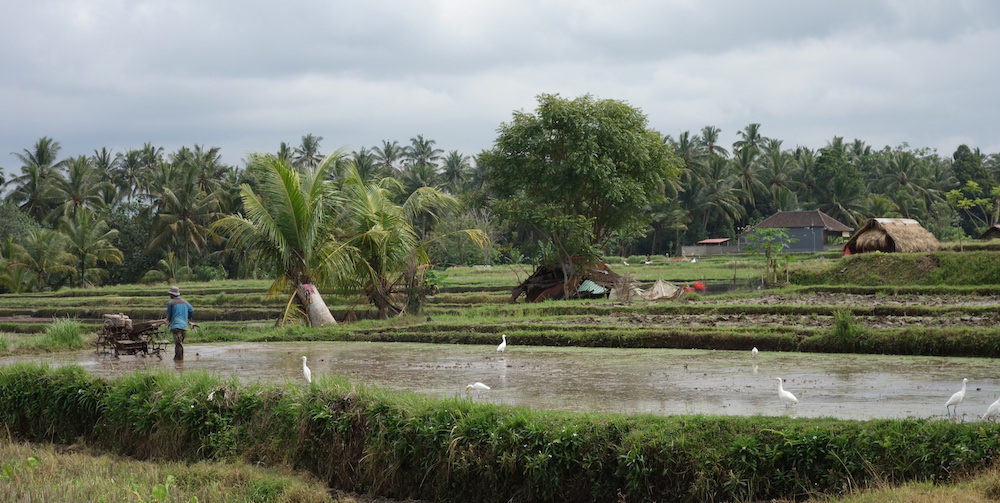 Ricefield walk
Ricefield walk
Food
In Ubud and Canggu, there were lots of western or western-influenced restaurants, but local food was around if you looked for it. It can be very cheap to eat like a local. I regularly ate a simple Indonesian-style lunch (a mountain of rice, some veggies, tempe, boiled egg and maybe a small piece of chicken or fish, and a healthy spoonful of spicy chili sauce) for 13,000 IDR = $1. The same fare is available for breakfast and dinner. If you spend a little more you can a little more variety. But food in Bali was a little more expensive than we expected. When eating out, for three of us we would on average spend about 140,000 IDR (about $10).
We spent one rainy Saturday morning doing a cooking class. Before getting to the cooking part we went to the big Ubud market with the guide to see where and how to buy certain things, produce etc.. Though it always feels silly for me being in a group of tourists, it was a fun class with 10 other people, and we enjoyed our food for lunch. Highlights from the menu:
- ayam soto (chicken soup)
- coconut curry with tofu
- sayur urab (sprouts and green beans seasoned with dried coconut, and a variety of spices)
- sate lilit (spiced and mashed meat grilled on sticks – we had with fish, but usually it is chicken)
- sweet peanut sauce
- sambal matah (condiment of onion, ginger and more than I remember)
- tempe fried in sweet soy sauce (Asa’s favorite)
- pandan crepe filled with shredded coconut and palm sugar for dessert (Asa’s real favorite)
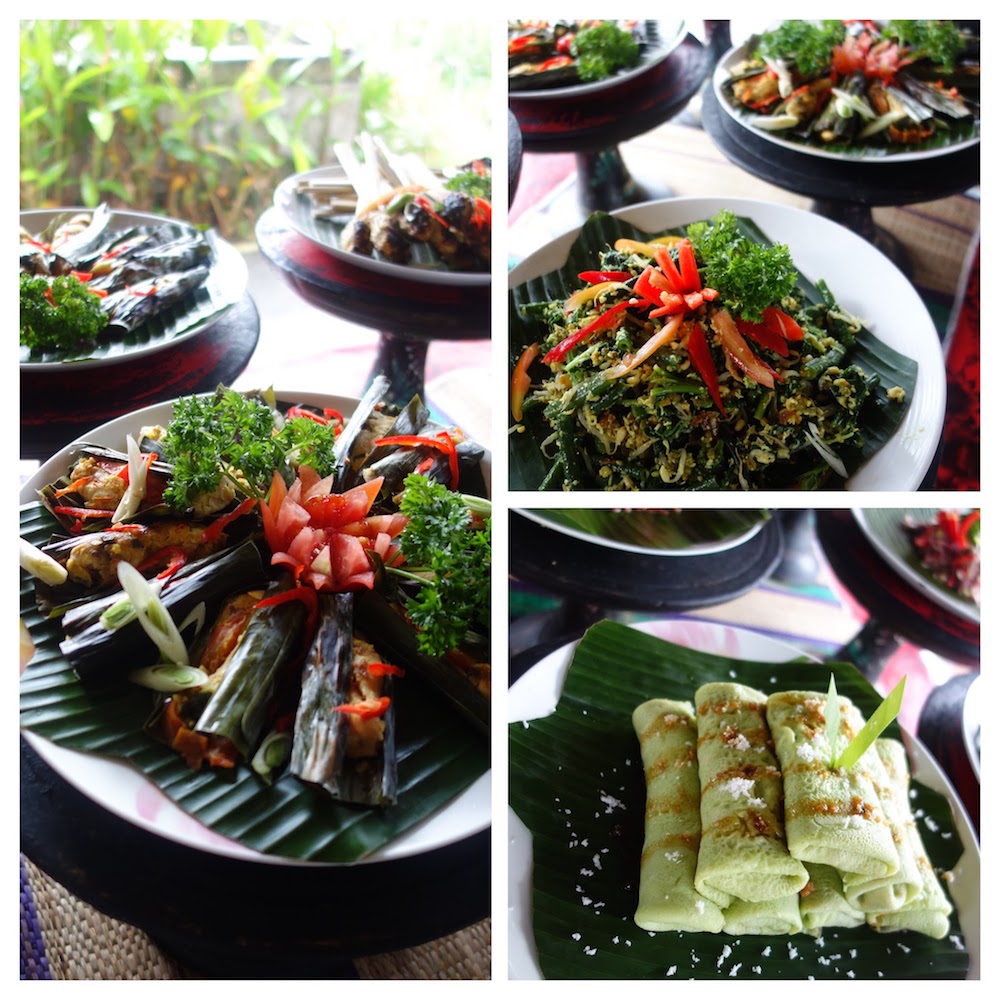 Food from our Balinese cooking class
Food from our Balinese cooking class
Other common Indonesian foods are:
- nasi goreng (fried rice, often with a fried egg on top)
- mie goreng (fried egg noodle)
- bihun goreng (fried rice noodle)
- nasi campur (a variety of small dishes, meat, tempe, vegetables served with rice)
- ayam kare (chicken curry)
- gado gado (veggies with peanut sauce, usually with potatoes, rice or noodles)
All these dishes were delicious. Some seasoned for tourist tastes, but many places we went were just for locals. My tolerance for spicy food has started to ratchet up, but my wife and son haven’t caught up.